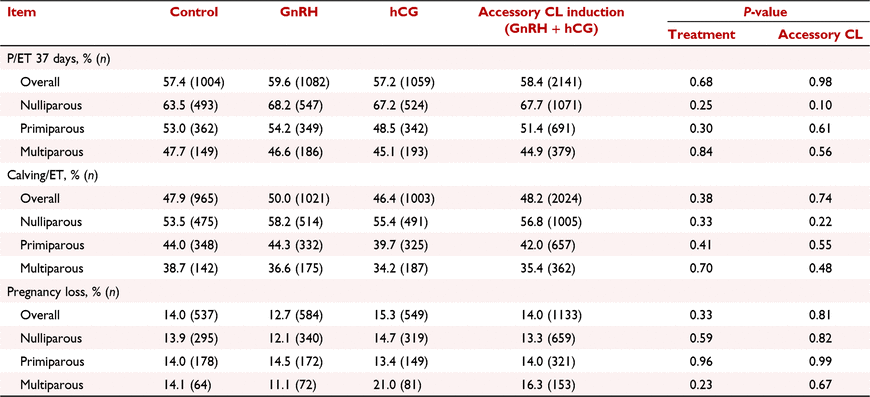77 The effect of inducing an accessory corpus luteum with gonadotrophin-releasing hormone or human chorionic gonadotrophin at the day of embryo transfer on fertility of recipient dairy heifers and lactating cows
M. S. El Azzi A B , J. L. L. Cardoso C , R. A. Landeo A C , J. C. de Souza B , J. H. F. Pontes C and J. P. N. Martins AA Department of Medical Sciences, School of Veterinary Medicine, University of Wisconsin-Madison, Madison, WI, USA
B Departamento de Zootecnia, Universidade Federal de Lavras, Lavras, MG, Brazil
C ABS Global Inc., DeForest, WI, USA
Reproduction, Fertility and Development 34(2) 274-275 https://doi.org/10.1071/RDv34n2Ab77
Published: 7 December 2021
© 2022 The Author(s) (or their employer(s)). Published by CSIRO Publishing on behalf of the IETS
The objective of this study was to determine the effect of inducing an accessory corpus luteum (CL) using gonadotrophin-releasing hormone (GnRH) and human chorionic gonadotrophin (hCG) at the day of embryo transfer (ET) on pregnancy per ET (P/ET) and calving/ET in recipient dairy heifers and lactating cows receiving in vitro-produced (IVP) embryos. Recipient dairy crossbred, Jersey and Holstein heifers (11–14 mo of age; n = 1565) and lactating cows (primiparous n = 1059; multiparous n = 539) detected in oestrus by tail chalk (Day 0) were used. On Day 6 (n = 5), Day 7 (n = 2592), Day 8 (n = 546), and Day 9 (n = 20) of the oestrous cycle, recipients were evaluated for the presence of a CL by transrectal palpation. Embryos were implanted in the uterine horn ipsilateral to the ovary with a CL (n = 2544 fresh IVP embryos, and n = 619 cryopreserved IVP embryos). After ET, recipients were randomly assigned to one of three treatments: Control, GnRH, or hCG. Control recipients did not receive any treatment. Recipients in hCG and GnRH treatments received 2500 IU of hCG (Chorulon; Merck Animal Health) and 86 µg of GnRH (Fertagyl; Merck Animal Health), respectively, immediately after ET. Pregnancy diagnosis was performed on Day 37 ± 3 by transrectal palpation, and calvings were recorded. Binomial data were analysed by logistic regression using the GLIMMIX procedure of SAS (SAS Institute Inc.), considering P ≤ 0.05 significant and 0.05 > P ≤ 0.10 a tendency. The statistical model included treatment, parity (nulliparous, primiparous, and multiparous), embryo type or embryo developmental stage, and the interactions parity × treatment and parity × treatment × embryo developmental stage. Heifers with induced accessory CL tend to have greater P/ET than controls (Table 1). When only stage 6 (blastocyst) and 7 (expanded blastocyst) fresh IVP embryos were considered in the analysis, heifers transferred with stage 6 embryos treated with hCG had greater P/ET than controls (51.1 vs. 74.5%; P = 0.02). Moreover, primiparous cows transferred with stage 7 embryos treated with GnRH had greater (P < 0.03) P/ET (59.5 vs. 47.1%) and calving/ET (49.5 vs. 38.0%) than hCG. In summary, the effects of inducing an accessory CL with hCG or GnRH on P/ET and calving/ET were distinct in different embryo developmental stages and parity of recipients.

|


